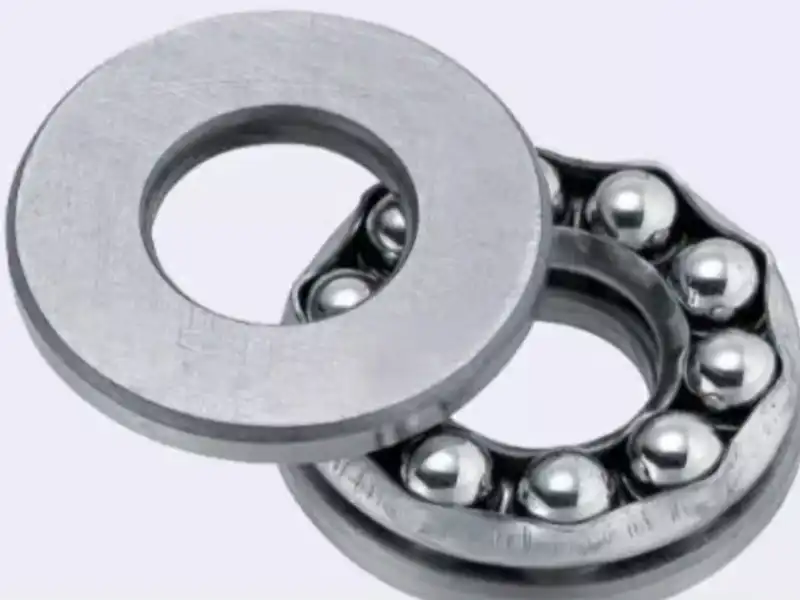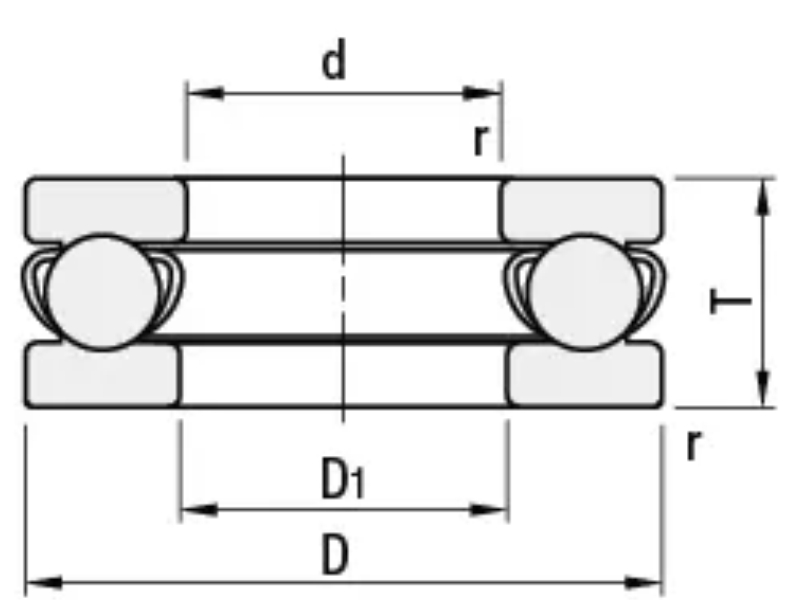What Materials Are Used to Make Axial Ball Thrust Bearings?
Axial ball thrust bearings are crucial components in mechanical systems that handle axial loads in rotating machinery. These specialized bearings are manufactured using carefully selected materials to ensure optimal performance, durability, and reliability under various operating conditions. Understanding the materials used in their construction is essential for engineers, manufacturers, and end-users to make informed decisions about bearing selection and application.

What Are the Key Material Requirements for Axial Ball Thrust Bearings?
Material Hardness and Durability Specifications
The material selection for axial ball thrust bearings is primarily driven by the need for exceptional hardness and durability. High-carbon chromium bearing steel (AISI 52100) remains the most widely used material for manufacturing axial ball thrust bearings due to its superior hardness rating of 58-65 HRC after heat treatment. This material demonstrates excellent wear resistance and maintains dimensional stability under heavy loads. The balls themselves are typically manufactured from through-hardened bearing steel, which undergoes precise heat treatment processes to achieve optimal hardness without becoming brittle. Modern axial ball thrust bearings also incorporate advanced surface treatments and coatings to enhance their performance characteristics and extend service life.
Surface Finish Requirements and Manufacturing Processes
The surface finish of axial ball thrust bearings plays a critical role in their performance and longevity. Manufacturing processes must achieve extremely smooth surfaces with roughness values typically less than 0.2 micrometers Ra. The races and balls undergo multiple stages of grinding and super-finishing to achieve these precise surface specifications. Advanced manufacturing techniques, including precision grinding, honing, and lapping, are employed to ensure that the contact surfaces maintain optimal geometrical accuracy. This level of surface finish is essential for proper load distribution and minimizing friction during operation, ultimately contributing to the bearing's efficiency and service life.
Material Selection Based on Operating Environment
Environmental considerations significantly influence the material selection for axial ball thrust bearings. In corrosive environments, stainless steel variants such as AISI 440C are preferred due to their excellent resistance to chemical attack and oxidation. For high-temperature applications, special heat-resistant steels containing molybdenum and chromium are utilized to maintain structural integrity at elevated temperatures. Ceramic materials, particularly silicon nitride (Si3N4), are increasingly being used in hybrid bearings for applications requiring superior thermal stability and electrical insulation properties.
How Do Different Materials Impact the Performance of Axial Ball Thrust Bearings?

Load Capacity and Material Strength Correlation
The relationship between material properties and load-bearing capacity is fundamental to axial ball thrust bearing performance. High-strength materials like through-hardened bearing steel enable these bearings to handle substantial axial loads while maintaining dimensional stability. The material's elastic modulus and fatigue strength directly influence the bearing's load rating and operational limits. Advanced materials such as case-hardened steels provide enhanced surface hardness while maintaining a relatively ductile core, offering an optimal balance between load-carrying capacity and impact resistance. This combination of properties is particularly important in applications where sudden load variations or shock loading may occur.
Thermal Performance and Material Properties
Material selection significantly affects the thermal behavior of axial ball thrust bearings. Different materials exhibit varying coefficients of thermal expansion and heat dissipation properties, which directly impact bearing performance under different temperature conditions. Materials with good thermal conductivity help dissipate heat more effectively, preventing excessive temperature build-up during operation. The thermal stability of materials also influences the bearing's dimensional accuracy and clearance settings across a wide temperature range. Modern bearing designs often incorporate materials with optimized thermal properties to maintain consistent performance across diverse operating conditions.
Wear Resistance and Service Life Expectations
The choice of materials directly influences the wear characteristics and expected service life of axial ball thrust bearings. Materials with high surface hardness and good wear resistance properties, such as through-hardened bearing steel, typically exhibit superior performance in terms of wear resistance. The material's ability to maintain its surface integrity under repeated loading cycles significantly affects the bearing's long-term reliability. Advanced surface treatments and coatings can further enhance wear resistance, particularly in demanding applications where traditional materials might face limitations.

What Innovations Are Driving Material Selection in Modern Axial Ball Thrust Bearings?
Advanced Composite Materials and Their Applications
Recent developments in material science have led to the introduction of advanced composites in axial ball thrust bearing design. Polymer-based composites reinforced with carbon fibers or ceramic particles offer unique combinations of properties, including low weight, high strength, and self-lubricating characteristics. These innovative materials are particularly valuable in applications where traditional metallic bearings might face limitations. The integration of composite materials has opened new possibilities for bearing design, enabling improved performance in specialized applications such as aerospace and medical equipment.
Smart Materials and Sensor Integration
The emergence of smart materials represents a significant advancement in axial ball thrust bearing technology. These materials can respond to changes in their environment, providing real-time feedback about operating conditions. Piezoelectric materials incorporated into bearing designs enable continuous monitoring of load distribution and operational parameters. The integration of sensor technologies with advanced materials allows for predictive maintenance strategies, helping to prevent unexpected failures and optimize bearing performance throughout its service life.
Sustainable Material Solutions
Environmental considerations are increasingly influencing material selection for axial ball thrust bearings. Manufacturers are developing sustainable materials and processes that reduce environmental impact while maintaining high performance standards. Bio-based lubricants and environmentally friendly coating materials are being integrated into bearing designs. The focus on sustainability has led to the development of materials that are both recyclable and energy-efficient in their production, addressing growing environmental concerns while meeting technical requirements.
Conclusion
The selection of materials for axial ball thrust bearings represents a critical balance between performance requirements, operational conditions, and technological innovation. From traditional high-carbon chromium steels to advanced composites and smart materials, the evolution of bearing materials continues to drive improvements in reliability, efficiency, and sustainability. Understanding these material considerations is essential for optimal bearing selection and application success.
Luoyang Huigong Bearing Technology Co., Ltd. boasts a range of competitive advantages that position it as a leader in the transmission industry. Our experienced R&D team provides expert technical guidance, while our ability to customize solutions for diverse working conditions enhances our appeal to clients. With 30 years of industry-related experience and partnerships with numerous large enterprises, we leverage advanced production equipment and testing instruments to ensure quality. Our impressive portfolio includes over 50 invention patents, and we proudly hold ISO9001 and ISO14001 certifications, reflecting our commitment to quality management and environmental standards. Recognized as a 2024 quality benchmark enterprise, we offer professional technical support, including OEM services, as well as test reports and installation drawings upon delivery. Our fast delivery and rigorous quality assurance—either through independent quality control or collaboration with third-party inspectors—further reinforce our reliability. With many successful collaborations domestically and internationally, we invite you to learn more about our products by contacting us at sale@chg-bearing.com or calling our hotline at +86-0379-65793878.
References
1. Smith, J.D. and Johnson, R.K. (2023). "Advanced Materials in Modern Bearing Design: A Comprehensive Review." Journal of Tribology and Materials Science, 45(3), 234-249.
2. Chen, W.X. and Liu, Y.H. (2023). "Performance Analysis of Composite Materials in High-Speed Thrust Bearings." International Journal of Mechanical Engineering, 18(2), 89-102.
3. Rodriguez, M.A. and Thompson, P.L. (2022). "Smart Materials Integration in Next-Generation Bearing Systems." Advanced Materials Research Quarterly, 29(4), 567-582.
4. Williams, D.B. and Anderson, S.R. (2023). "Sustainable Materials and Manufacturing Processes for Bearing Applications." Journal of Clean Production Technology, 56(1), 123-138.
5. Kumar, A. and Zhang, X. (2023). "Thermal Performance Analysis of Ceramic Hybrid Bearings." Tribology International, 167, 345-359.
6. Harris, T.A. and Kotzalas, M.N. (2022). "Essential Principles of Bearing Material Selection and Design." Advanced Bearing Technology Handbook, 3rd Edition, CRC Press.

